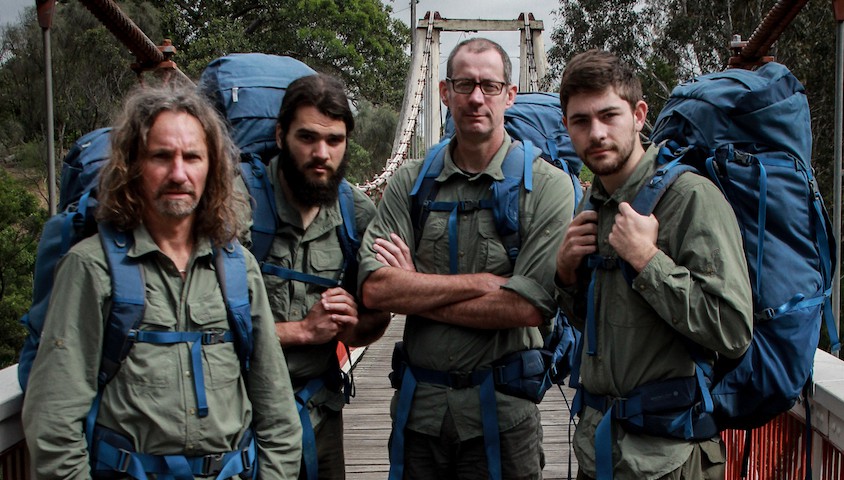Michael switched on his radio one sleepless night. It was meant to be a quiet distraction, but the presenter and her guest immediately grabbed his attention.
Colin McPhedran, in his eighties, was describing his escape from Burma in 1942 as Japanese troops swallowed the country – the story of three children and their mother attempting 450 kilometres of mountains on foot during a monsoon. By journey’s end, Colin was barely alive and his family were dead.
Michael did eventually sleep that night, but the next day contacted Colin’s war correspondent son, Ian, and introduced the idea of replicating his father’s trek. Support was immediate. In fact, Ian was keen to participate. It was then that Michael described the trek idea to me.
The McPhedran family welcomed us and fleshed out Colin’s persona for us.
We then naively began the process of applying to traverse Kachin State, largely closed to foreigners. Nobody had ever before done what we were proposing – there is no process to apply to. After three and half years, we last month received that written permission – a world first.
Establishing the track route and event chronology took six months of book work, library visits, emails to academics and bleary nights in front of the computer, earning incremental, exciting little gains, a gradual accumulation of facts and rumours on sheaves of paper and dog-eared WWII maps. (3am one particular morning, “Mate, I know when and where Daw Ni and Ethel died!”)
Through this exercise, we also learned there were many health issues in Myanmar and decided to use our Trek as a platform in our small way to support some of the need in the country, but we had no expertise. At the time I was studying at the Alfred hospital and Burnet Institute: the answer was obvious. We established a link with Burnet, and the awareness we raise we hope will prompt supporters to donate to their important work in Myanmar – they’ve been working with communities there since 2003.
Naturally, things have gone up and down.
An IT tech at my local café, John, volunteered to build our first website.
We parted from our first travel operator when they wouldn’t meet our needs (and were suspiciously costly).
Progress lurched forward when Michael met with the Australian Ambassador to Myanmar, Bronte Moules.
Over time, four trekkers have withdrawn for personal reasons.
In early 2015, I was studying in India and the course co-ordinator, Matt, asked if we had a film-maker. At that stage I’d contacted nine producers (including David Bradbury), all of whom had been unavailable.
Matt referred me to “a film maker I know who’s studying, but really only to formalise what he already knows”.
I arranged to meet with one Kenton Reeder a week later. In the next few days I received a torrent of research from Kenton regarding context-appropriate cameras, lenses, batteries, climate considerations, commercially useful file-types, customs & budget limitations and his colleagues’ direct experience in Myanmar. I couldn’t wait to meet this man, and pictured a grizzled and battered veteran. It blew my doors off when (outside the Paris Cat Jazz Club one balmy Melbourne evening) I found myself seated opposite a clear-faced twenty-year-old in red jeans and a herringbone jacket.
Kenton expected a chat about a YouTube clip, but 15 minutes later he was part of the team.
By mid-2015 the team had started training hard.
In September we held a launch in Sydney.
In October we presented at the National Press Club.
Then, in November, we called it off.
The unrest leading up to the Myanmar National Election was becoming too dangerous. This was a wrenching decision. The election result was historic – Aung San Su Kyi was swept into power – but, with that, all our established connections and arrangements collapsed completely. We were back at square one.
Early this year we again mobilised, engaged a project manager, reformatted the media, rebuilt the website and re-doubled our efforts.
We found the right travel operator.
In June, Kenton and I spent a whirlwind fortnight of 18-hour-days in Myanmar meeting with Government ministers to progress our case, travelled to the start of our proposed route, rigorously field-tested our camera gear (in some cases to destruction), and located Colin’s boyhood home.
On return, Kenton produced the video material on the website and we welcomed Trekker No. 4, Jacob, our youth worker friend. (As I write, a new video is days away from release, and we are developing ideas for the documentary that will be produced on return. To this end, we’re having encouraging talks with SBS.)
Mont Adventure Equipment are sponsoring our gear, Bupa Global our insurance, Terra Rosa Gear custom protection for our cameras. We have ongoing and extensive consultation with many groups and have well-thought through risk mitigation strategies in place.
We continue to receive communication from people all over the world who have family ties to the history of that original desperate and deadly exodus. We will be carrying Colin’s ashes.
Three and a half years later, Michael, Kenton, Jacob and I comprise the walking team for The Colin McPhedran Trek. The four of us have very different backgrounds and range in age from 21 to 63 years, but we will be fit and prepared.
Naturally, there’s always been a team of dedicated people around us.
Of the AUD$60,000 we need to cover our logistics, we are at the halfway mark. Our GoFundMe platform, established for this purpose, continues to steadily accrue support from wonderful people.
Much still remains to be done – mostly around communications, logistics and gear, and any assistance and support we can get with this is appreciated.
We are excited: it’s been a long time in the making, and then suddenly a minister’s signature changed fantasy into reality! Everything else – injury, conflict, leeches, head hunters, sand flies, mud and mines, not to mention wandering through a tiger sanctuary – we will process as we go!



